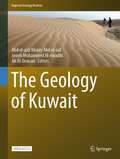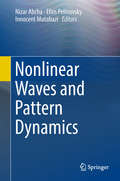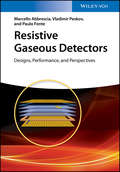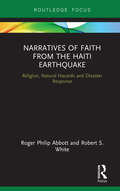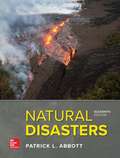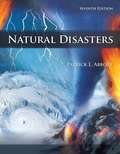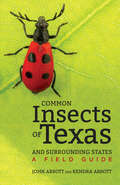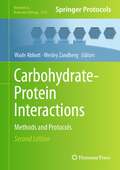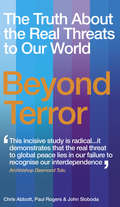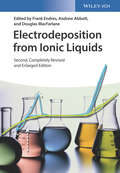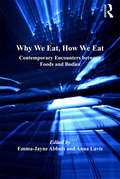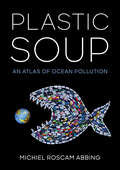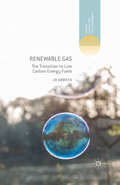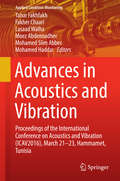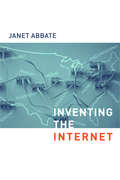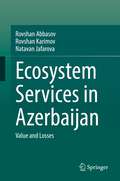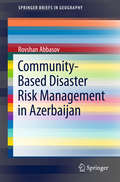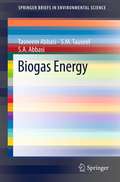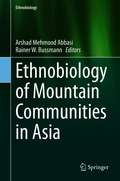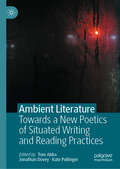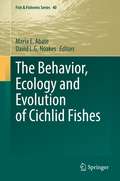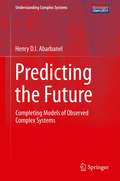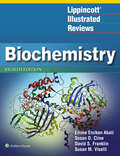- Table View
- List View
The Geology of Kuwait (Regional Geology Reviews)
by Abd el-aziz Khairy Abd el-aal Jasem Mohammed Al-Awadhi Ali Al-DousariThis open access book contains a set of chapters covering all aspects of geosciences related to Kuwait and adjacent regions, including Iran, Saudi Arabia and the Arab Gulf states. It covers basic information about the geology including a wide range of geoscientific disciplines such as marine geology, structural geology, hydrogeology and geophysics related to the region. This book is aimed at researchers and students, as well as professionals in the field of hazard mitigation and petroleum exploration.
Nonlinear Waves and Pattern Dynamics
by Nizar Abcha Efim Pelinovsky Innocent MutabaziThis book addresses the fascinating phenomena associated with nonlinear waves and spatio-temporal patterns. These appear almost everywhere in nature from sand bed forms to brain patterns, and yet their understanding still presents fundamental scientific challenges. The reader will learn here, in particular, about the current state-of-the art and new results in: Nonlinear water waves: resonance, solitons, focusing, Bose-Einstein condensation, as well as and their relevance for the sea environment (sea-wind interaction, sand bed forms, fiber clustering) Pattern formation in non-equilibrium media: soap films, chimera patterns in oscillating media, viscoelastic Couette-Taylor flow, flow in the wake behind a heated cylinder, other pattern formation. The editors and authors dedicate this book to the memory of Alexander Ezersky, Professor of Fluid Mechanics at the University of Caen Normandie (France) from September 2007 to July 2016. Before 2007, he had served as a Senior Scientist at the Institute of Applied Physics of the Russian Academy of Sciences in Nizhny Novgorod (Russia). The chapters have been written by leading scientists in Nonlinear Physics, and the topics chosen so as to cover all the fields to which Prof. Ezersky himself contributed, by means of experimental, theoretical and numerical approaches. The volume will appeal to advanced students and researchers studying nonlinear waves and pattern dynamics, as well as other scientists interested in their applications in various natural media.
Resistive Gaseous Detectors: Designs, Performance, and Perspectives
by Marcello Abbrescia Vladimir Peskov Paulo FonteThis first book to critically summarize the latest achievements and emerging applications within this interdisciplinary topic focuses on one of the most important types of detectors for elementary particles and photons: resistive plate chambers (RPCs). In the first part, the outstanding, international team of authors comprehensively describes and presents the features and design of single and double-layer RPCs before covering more advanced multi-layer RPCs. The second part then focuses on the application of RPCs in high energy physics, materials science, medicine and security. Throughout, the experienced authors adopt a didactic approach, with each subject presented in a simple way, increasing in complexity step by step.
Narratives of Faith from the Haiti Earthquake: Religion, Natural Hazards and Disaster Response (Routledge Focus on Religion)
by Roger Philip Abbott Robert S. WhiteThis book presents an in-depth ethnographic case study carried out in the years following the 2010 Haiti earthquake to present the role of faith beliefs in disaster response. The earthquake is one of the most destructive on record, and the aftermath, including a cholera epidemic and ongoing humanitarian aid, has continued for years following the catastrophe. Based on dozens of interviews, this book gives primacy to survivors’ narratives. It begins by laying out the Haitian context, before presenting an account of the earthquake from survivors’ perspectives. It then explores in detail how the earthquake affected the religious, mainly Christian, faith of survivors and how religious faith influenced how they responded to, and are recovering from, the experience. The account is also informed by geoscience and the accompanying "complicating factors." Finally, the Haitian experience highlights the significant role that religious faith can play alongside other learned coping strategies in disaster response and recovery globally. This book contributes an important case study to an emerging literature in which the influence of both religion and narrative is being recognised. It will be of interest to scholars of any discipline concerned with disaster response, including practical theology, anthropology, psychology, geography, Caribbean studies and earth science. It will also provide a resource for non-governmental organisations.
Natural Disasters
by Patrick Leon AbbottNatural Disasters, 11th edition focuses on explaining how the normal processes of Earth concentrate their energies and deal heavy blows to humans and their structures. Students have a natural curiosity about natural disasters and why they occur. This text explains why natural disasters occur by interweaving the themes of Energy sources, Plate tectonics, climate change, Earth Processes, geologic time, the complexities of multiple variables operating simultaneously throughout the text. Detailed and interesting Case histories are also intertwined with current content to give students a broad historical understanding of our dynamic and evolving planet.
Natural Disasters (7th edition)
by Patrick Leon AbbottNatural Disasters, 7th edition, focuses on how the normal processes of the Earth concentrate their energies and deal heavy blows to humans and their structures. It is concerned with how the natural world operates and, in so doing, kills and maims humans and destroys their works. Throughout the book, certain themes are maintained: energy sources underlying disasters plate tectonics and climate change; earth processes operating in rock, water, and atmosphere; significance of geologic time; complexities of multiple variables operating simultaneously; detailed and readable case studies.
Common Insects of Texas and Surrounding States: A Field Guide
by John C. Abbott Kendra AbbottA comprehensive field guide to Texas&’s insects, featuring 1,300 species and over 2,700 photographs. Thanks to its size and geographic position, Texas is home to nearly 30,000 species of insects, likely making its insect population the most diverse in the nation. Ranging from eastern and western to temperate and tropical species, this vast array of insects can be difficult to identify. In Common Insects of Texas and Surrounding States, John and Kendra Abbott have created the state&’s most comprehensive field guide to help readers recognize and understand these fascinating creatures. Containing 1,300 species and more than 2,700 photographs, this guide offers a wealth of information about the characteristics and behaviors of Texas&’s insects. Each chapter introduces an order with a discussion of general natural history and a description of other qualities helpful in distinguishing its various species, while every species&’ entry provides a state map showing where it is most likely to be found, a key displaying its seasonal distribution, information about its habitat, and corresponding photos. Featuring colored tabs for quick reference, a glossary, and information about other arthropods, this guide is the perfect companion for anyone wanting to identify and learn more about the many insects of Texas.&“Expertly written and beautifully illustrated, this exceptional book will be of interest to both professional and beginning naturalists.&” —Edward O. Wilson, University Research Professor Emeritus, Harvard University
Common Insects of Texas and Surrounding States: A Field Guide
by John C. Abbott Kendra AbbottA comprehensive field guide to Texas&’s insects, featuring 1,300 species and over 2,700 photographs. Thanks to its size and geographic position, Texas is home to nearly 30,000 species of insects, likely making its insect population the most diverse in the nation. Ranging from eastern and western to temperate and tropical species, this vast array of insects can be difficult to identify. In Common Insects of Texas and Surrounding States, John and Kendra Abbott have created the state&’s most comprehensive field guide to help readers recognize and understand these fascinating creatures. Containing 1,300 species and more than 2,700 photographs, this guide offers a wealth of information about the characteristics and behaviors of Texas&’s insects. Each chapter introduces an order with a discussion of general natural history and a description of other qualities helpful in distinguishing its various species, while every species&’ entry provides a state map showing where it is most likely to be found, a key displaying its seasonal distribution, information about its habitat, and corresponding photos. Featuring colored tabs for quick reference, a glossary, and information about other arthropods, this guide is the perfect companion for anyone wanting to identify and learn more about the many insects of Texas.&“Expertly written and beautifully illustrated, this exceptional book will be of interest to both professional and beginning naturalists.&” —Edward O. Wilson, University Research Professor Emeritus, Harvard University
Damselflies of Texas
by John C. AbbottOn any warm summer day, you can easily observe damselflies around a vegetated pond or the rocks along the banks of a stream. Like the more familiar dragonfly, damselflies are among the most remarkably distinctive insects in their appearance and biology, and they have become one of the most popular creatures sought by avocational naturalists. Damselflies of Texas is the first field guide dedicated specifically to the species found in Texas. It covers 77 of the 138 species of damselflies known in North America, making it a very useful guide for the entire United States. Each species account includes:- illustrations of as many forms (male, female, juvenile, mature, and color morphs) as possible- common and scientific names, with pronunciation- distribution map- key features- identifying characteristics- discussion of similar species- status in Texas- habitat, seasonality, and general commentsIn addition to photographing damselflies in the wild, the author and illustrator have developed a new process for illustrating each species by scanning preserved specimens and digitally painting them. The resulting illustrations show detail that is not visible in photographs. The book also contains chapters on damselfly anatomy, life history, conservation, names, and photography, as well as a list of species that may eventually be discovered in Texas, state and global conservation rankings, seasonality of all species in chronological order, and additional resources and publications on the identification of damselflies.
Carbohydrate-Protein Interactions: Methods and Protocols (Methods in Molecular Biology #2657)
by D. Wade Abbott Wesley F. ZandbergThis second edition provides new and updated tools for studying protein-carbohydrate interactions ranging from traditional biochemical methods to state-of-the-art techniques. This book focuses on four different research themes detailing methods for screening and quantifying CAZyme activity, investigating the interactions between proteins, carbohydrate ligands, methods for the visualization of carbohydrates, protein-carbohydrate complexes, structural and “omic” approaches for studying systems of CAZymes. Written in the format of the highly successful Methods in Molecular Biology series, each chapter includes an introduction to the topic, lists necessary materials and methods, includes tips on troubleshooting and known pitfalls, and step-by-step, readily reproducible protocols. Authoritative and cutting-edge, Carbohydrate- Protein Interactions: Methods and Protocols, Second Edition aims to be comprehensive guide for researchers in the field.
Beyond Terror: The Truth About the Real Threats to Our World
by Chris Abbott John Sloboda Paul RogersIs international terrorism really the single greatest threat to world security?Since the 9/11 attacks, many Western governments assume terrorism to be the greatest threat we face. In response, their dangerous policies attempt to maintain control and keep the status quo by using overwhelming military force. This important book shows why this approach has been such a failure, and how it distracts us from other, much greater, threats of climate change, competition over resources, marginalisation of the majority of the world and global militarisation.Unless urgent, coordinated action is taken in the next 5-10 years on all these issues it will be almost imossible to avoid the earth becoming a highly unstable place by the middle years of this century. Beyond Terror offers an alternative path for politicians, journalists and concerned citizens alike.
Electrodeposition from Ionic Liquids
by Andrew Abbott Douglas Macfarlane Frank EndresEdited by distinguished experts in this expanding field and with specialist contributions, this overview is the first of its kind to focus on electrodeposition from ionic liquids. This second edition has been completely revised and updated with approximately 20% new content and has been expanded by five chapters to cover the following topics: -Bulk and Interface Theory -Nanoscale Imaging including AFM, In situ STM and UHV-STM -Impedance Spectroscopy -Process Scale-up including Brighteners -Speciation and Redox Properties. The result is essential reading for electrochemists, materials scientists, chemists in industry, physical chemists, chemical engineers, inorganic and organic chemists.
Why We Eat, How We Eat: Contemporary Encounters between Foods and Bodies (Critical Food Studies)
by Emma-Jayne Abbots Anna LavisWhy We Eat, How We Eat maps new terrains in thinking about relations between bodies and foods. With the central premise that food is both symbolic and material, the volume explores the intersections of current critical debates regarding how individuals eat and why they eat. Through a wide-ranging series of case studies it examines how foods and bodies both haphazardly encounter, and actively engage with, one another in ways that are simultaneously material, social, and political. The aim and uniqueness of this volume is therefore the creation of a multidisciplinary dialogue through which to produce new understandings of these encounters that may be invisible to more established paradigms. In so doing, Why We Eat, How We Eat concomitantly employs eating as a tool - a novel way of looking - while also drawing attention to the term 'eating' itself, and to the multiple ways in which it can be constituted. The volume asks what eating is - what it performs and silences, what it produces and destroys, and what it makes present and absent. It thereby traces the webs of relations and multiple scales in which eating bodies are entangled; in diverse and innovative ways, contributors demonstrate that eating draws into relationships people, places and objects that may never tangibly meet, and show how these relations are made and unmade with every mouthful. By illuminating these contemporary encounters, Why We Eat, How We Eat offers an empirically grounded richness that extends previous approaches to foods and bodies.
Plastic Soup: An Atlas of Ocean Pollution
by Michiel Roscam AbbingPlastics have transformed every aspect of our lives. Yet the very properties that make them attractive—they are cheap to make, light, and durable—spell disaster when trash makes its way into the environment. Plastic Soup: An Atlas of Ocean Pollution is a beautifully-illustrated survey of the plastics clogging our seas, their impacts on wildlife and people around the world, and inspirational initiatives designed to tackle the problem. In Plastic Soup, Michiel Roscam Abbing of the Plastic Soup Foundation reveals the scope of the issue: plastic trash now lurks on every corner of the planet. With striking photography and graphics, Plastic Soup brings this challenge to brilliant life for readers. Yet it also sends a message of hope; although the scale of the problem is massive, so is the dedication of activists working to check it. Plastic Soup highlights a diverse array of projects to curb plastic waste and raise awareness, from plastic-free grocery stores to innovative laws and art installations. According to some estimates, if we continue on our current path, the oceans will contain more plastic than fish by the year 2050. Created to inform and inspire readers, Plastic Soup is a critical tool in the fight to reverse this trend.
Renewable Gas: The Transition to Low Carbon Energy Fuels (Energy, Climate and the Environment)
by Jo AbbessThe author looks at the prospects for a transition from natural gas to low carbon gas, which could take several decades, and at how this will depend on the evolution of the fossil fuel industry. She investigates the technologies and energy systems for making the best use of renewable gas resources.
Advances in Acoustics and Vibration: Proceedings of the International Conference on Acoustics and Vibration (ICAV2016), March 21-23, Hammamet, Tunisia (Applied Condition Monitoring #5)
by Mohamed Slim Abbes Fakher Chaari Mohamed Haddar Tahar Fakhfakh Lasaad Walha Moez AbdennadherThe book provides readers with a snapshot of recent research and industrial trends in field of industrial acoustics and vibration. Each chapter, accepted after a rigorous peer-review process, reports on a selected, original piece of work presented and discussed at International Conference on Acoustics and Vibration (ICAV2016), which was organized by the Tunisian Association of Industrial Acoustics and Vibration (ATAVI) and held March 21-23, in Hammamet, Tunisia. The contributions, mainly written by north African authors, covers advances in both theory and practice in a variety of subfields, such as: smart materials and structures; fluid-structure interaction; structural acoustics as well as computational vibro-acoustics and numerical methods. Further topics include: engines control, noise identification, robust design, flow-induced vibration and many others. This book provides a valuable resource for both academics and professionals dealing with diverse issues in applied mechanics. By combining advanced theories with industrial issues, it is expected to facilitate communication and collaboration between different groups of researchers and technology users.
Inventing the Internet (Inside Technology)
by Janet AbbateJanet Abbate recounts the key players and technologies that allowed the Internet to develop; but her main focus is always on the social and cultural factors that influenced the Internet's design and use.Since the late 1960s the Internet has grown from a single experimental network serving a dozen sites in the United States to a network of networks linking millions of computers worldwide. In Inventing the Internet, Janet Abbate recounts the key players and technologies that allowed the Internet to develop; but her main focus is always on the social and cultural factors that influenced the Internets design and use. The story she unfolds is an often twisting tale of collaboration and conflict among a remarkable variety of players, including government and military agencies, computer scientists in academia and industry, graduate students, telecommunications companies, standards organizations, and network users.The story starts with the early networking breakthroughs formulated in Cold War think tanks and realized in the Defense Department's creation of the ARPANET. It ends with the emergence of the Internet and its rapid and seemingly chaotic growth. Abbate looks at how academic and military influences and attitudes shaped both networks; how the usual lines between producer and user of a technology were crossed with interesting and unique results; and how later users invented their own very successful applications, such as electronic mail and the World Wide Web. She concludes that such applications continue the trend of decentralized, user-driven development that has characterized the Internet's entire history and that the key to the Internet's success has been a commitment to flexibility and diversity, both in technical design and in organizational culture.
Ecosystem Services in Azerbaijan: Value and Losses
by Rovshan Abbasov Rovshan Karimov Natavan JafarovaThis book aims to draw readers' attention to the benefits once present nature in Azerbaijan. Over the past hundred years, much of this has been lost because of the neglect of the intrinsic values of nature by both managers and local authorities, and the overuse of natural resources. For example, oil pollution and overfishing in the Caspian Sea have almost destroyed its fish and caviar resources. In this volume, the authors distinguish between the concepts of "gain" and "income" and show readers that short-term benefits based solely on monetary income deprive people and nature itself of long-term, lasting value. The book provides readers with real historical information, discusses the interactions between humans and nature, and shows, with real data and trends, the consequences of anthropogenic activity on natural resources in Azerbaijan. The authors cover fish, water, forest, mountain, and pasture ecosystems, draw attention to the impacts that pollution and other forms of environmental degradation have had on these resources, and the show the impact that resource depletion on people’s livelihoods. The book is intended primarily for managers, policymakers, students, and academics, and will be of interest to natural scientists, historians, and students of culture.
Community-Based Disaster Risk Management in Azerbaijan (SpringerBriefs in Geography)
by Rovshan AbbasovThis book illustrates the main factors of vulnerability and gives a clear picture about the possible interventions to reduce disaster risks both in schools and communities in Azerbaijan. A new methodology for child centered vulnerability assessments both on school and community levels has been developed. This methodology can be used to assess the level of vulnerability of schools and communities. The book is a newly prepared training manual which will help practitioners conduct trainings for government and community organizations. While the book is focused on a specific region, the suggested approach is generic and can be used elsewhere.
Biogas Energy (SpringerBriefs in Environmental Science #2)
by Tasneem Abbasi S. M. Tauseef S. A. AbbasiIn recent years, the importance of biogas energy has risen manifold and has become universal. This is due to the realization that biogas capture and utilization has great potential in controlling global warming. By capturing biogas wherever it is formed, we not only tap a source of clean energy, but we also prevent the escape of methane to the atmosphere. Given that methane has 25 times greater global warming potential than CO2, methane capture through biogas energy in this manner can contribute substantially towards global warming control.
Ethnobiology of Mountain Communities in Asia (Ethnobiology)
by Arshad Mehmood Abbasi Rainer W. BussmannNatural resources and associated biological diversity provide the basis of livelihood for human population, particularly in the rural areas and mountain regions across the globe. Asia is home to the world's highest mountain regions including the Himalayas, Karakorum and Hindukush. These regions are renowned around the globe because of their unique beauty, climate, and biocultural diversity. Because of geoclimatic conditions, the mountains of Asia are medicinal and food plant diversity hot spots. The indigenous communities residing in the valleys of these mountains have their own culture and traditions, and have a long history of interaction with the surrounding plant diversity. Local inhabitants of these mountains areas possess significant traditional knowledge of plant species used as food, medicine, and for cultural purposes. So far, many workers have reported traditional uses of plant species from different regions of Asia including some mountain areas; however, there is not one inclusive document on the ethnobotany of mountains in Asia. This book provides a comprehensive overview on ethno-ecological knowledge and cross cultural variation in the application of plant species among various communities residing in the mountains of Asia; cross cultural variation in traditional uses of plant species by the mountain communities; high value medicinal and food plant species; and threats and conservation status of plant species and traditional knowledge. This book should be useful to researchers of biodiversity and conservation, ethnobiologists, ethnoecologists, naturalists, phytochemists, pharmacists, policy makers, and all who have a devotion to nature.
Ambient Literature: Towards a New Poetics of Situated Writing and Reading Practices
by Tom Abba Jonathan Dovey Kate PullingerThis book considers how a combination of place-based writing and location responsive technologies produce new kinds of literary experiences. Building on the work done in the Ambient Literature Project (2016–2018), this books argues that these encounters constitute new literary forms, in which the authored text lies at the heart of an embodied and mediated experience. The visual, sonic, social and historic resources of place become the elements of a live and emergent mise-en-scène. Specific techniques of narration, including hallucination, memory, history, place based writing, and drama, as well as reworking of traditional storytelling forms combine with the work of app and user experience design, interaction, software authoring, and GIS (geographical information systems) to produce ambient experiences where the user reads a textual and sonic literary space. These experiences are temporary, ambiguous, and unpredictable in their meaning but unlike the theatre, the gallery, or the cinema they take place in the everyday shared world. The book explores the potentiality of a new literary form produced by the exchange between location-aware cultural objects, writers and readers. This book, and the work it explores, lays the ground for a new poetics of situated writing and reading practices.
The Behavior, Ecology and Evolution of Cichlid Fishes (Fish & Fisheries Series #40)
by Maria E. Abate David L. G. NoakesThis volume constitutes the most recent and most comprehensive consideration of the largest family of bony fishes, the Cichlidae. This book offers an integrated perspective of cichlid fishes ranging from conservation of threatened species to management of cichlids as invasive species themselves. Long-standing models of taxonomy and systematics are subjected to the most recent applications and interpretations of molecular evidence and multivariate analyses; and cichlid adaptive radiations at different scales are elucidated. The incredible diversity of endemic cichlid species in African lakes is revisited as possible examples of sympatric speciation and as serious cases for management in complex anthropogenic environments. Extreme hydrology and bathymetry as driver of micro-allopatric speciation is explored in the African riverine hotspot of diversity of the lower Congo River. Dramatic new molecular evidence draws attention to the complex taxonomy and systematics of Neotropical cichlids including the crater lakes of Central America. Molecular genetics, genomics, imaging tools and field study techniques assess the roles of natural, sexual and kin selection in shaping cichlid traits and beyond. The complex behavioral adaptations of cichlids are considered from a number of sub-disciplines including sensory biology, neurobiology, development, and evolutionary ecology. Most importantly, this volume puts forth a wealth of new interpretations, explanatory hypotheses and proposals for practical management and applications that will shape the future for these remarkable fishes in nature as well as their use as models for the study of biology.
Predicting the Future
by Henry AbarbanelThrough the development of an exact path integral for use in transferring information from observations to a model of the observed system, the author provides a general framework for the discussion of model building and evaluation across disciplines. Through many illustrative examples drawn from models in neuroscience, geosciences, and nonlinear electrical circuits, the concepts are exemplified in detail. Practical numerical methods for approximate evaluations of the path integral are explored, and their use in designing experiments and determining a model's consistency with observations is explored.
Lippincott Illustrated Reviews: Biochemistry (Lippincott Illustrated Reviews Series)
by Emine E Abali Susan D Cline David S Franklin Susan M ViselliPraised by faculty and students for more than two decades, Lippincott® Illustrated Reviews: Biochemistry is the long-established go-to resource for mastering the essentials of biochemistry. This best-selling text helps students quickly review, assimilate, and integrate large amounts of critical and complex information, with unparalleled illustrations that bring concepts to life. Like other titles in the popular Lippincott® Illustrated Review Series, this text follows an intuitive outline organization and boasts a wealth of study aids that clarify challenging information and strengthen retention and understanding. This updated and revised edition emphasizes clinical application and features new exercises, questions, and accompanying digital resources to ready students for success on exams and beyond.
